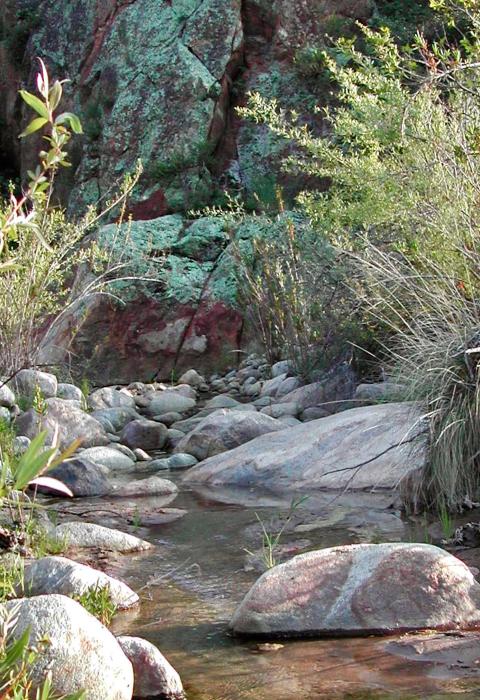Bautista Creek
California
Bautista Creek drains the San Jacinto Mountains and provides an important migration corridor for birds passing from the desert to the valley. The creek and its surrounding riparian area shelter endangered arroyo toads, southwestern willow flycatchers, Quino checkerspot butterflies, the slender-horned spineflower, and many other sensitive species. It contains the largest number of endangered wildlife species on the San Bernardino National Forest.
Designated Reach
March 30, 2009. From the San Bernardino National Forest boundary in Section 36, Township 6 South, Range 2 East to the San Bernardino National Forest boundary in Section 2, Township 6 South, Range 1 East.
Outstandingly Remarkable Values
Botany
Bautista Creek provides nationally significant, occupied habitat for the slender-horned spine-flower, a federally endangered plant species. Within the four southern California National Forests, this plant occurs only on the Cleveland (31 acres) and San Bernardino National Forests (17 acres). The Bautista Creek population is significant because: 1) it is the only known population on the forest; 2) consists of a large number of individuals; and 3) the plants are scattered over a two-mile stretch of the creek. This annual plant occurs on alluvial benches in or adjacent to the stream channel where habitat is created by the deposition of sediments carried by the stream. The habitat is dependent on the proper functioning condition of the creek; therefore, downstream habitat is affected by hydrologic alterations upstream. Proper management of water and watersheds on the forest is critical to the species, because the plant habitat is tied to hydrology and fluvial geomorphology and also because many of the remaining 23 occurrences of the spine-flower occur downstream of National Forest System lands.
Culture
Bautista Creek has many Native American sites of exceptional human-interest along the whole length of the canyon. These sites reflect all aspects of Native American life and have exceptional human interest value to the local Native American and tribal community, as well as having scientific value. Most of the sites represent occupation or habitation sites, while others represent specialized activities, such as milling features for food processing. While few archaeological investigations have been undertaken, ethnohistoric Cahuilla village sites occur at the upper portion of the drainage.
History
The canyon was used as a route of the earliest efforts to reach the San Francisco Bay area from Sonora, Mexico. Of special note are the travels of explorer Juan Bautista de Anza through the canyon in 1774 and again in 1776. This trail route is designated as a National Historic Trail; within the river corridor, the trail follows the Bautista Canyon Road corridor itself (not a trail).
Wildlife
Bautista Creek is home to nationally significant populations of the arroyo southwestern toad, San Bernardino kangaroo rat, and nesting occurrences of the southwestern willow flycatcher, all federally endangered wildlife species. The U.S. Fish and Wildlife Service has also designated this area as critical habitat for the Quino checkerspot butterfly, a federally endangered insect. Fourteen U.S. Forest Service sensitive species are present, including the silvery legless lizard, San Diego horned lizard, coastal rosy boa, Hammond two-striped garter snake, San Bernardino ringneck snake, purple martin, San Diego ringneck snake, Wilson’s warbler, yellow warbler, yellow-breasted chat, Swainson’s thrush, yellowbreasted chat, and mountain lion. The greenest tiger beetle, a rare invertebrate was collected in the 1970’s along the creek, may still occur. This creek was identified as an area of high ecological significance within the four southern California National Forests in 1999. Bautista Creek possesses the largest number of endangered wildlife species of any location on the forest.

